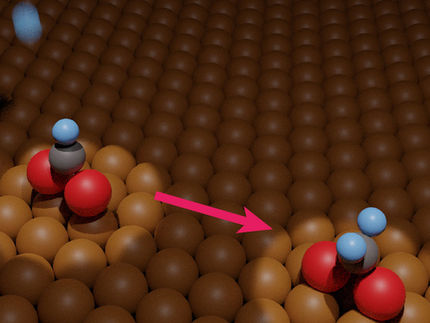An efficient multifunctional catalyst for CO2 hydrogenation to gasoline
Converting CO2 from a detrimental greenhouse gas into value-added liquid fuels not only contributes to mitigating CO2 emissions, but also reduces dependence on petrochemicals. However, since CO2 is a fully oxidized, thermodynamically stable and chemically inert molecule, the activation of CO2 and its hydrogenation to hydrocarbons or other alcohols are challenging tasks. Most research to date, not surprisingly, is focusing on selective hydrogenation of CO2 to short-chain products, while few studies on long-chain hydrocarbons, such as gasoline-range (C5-C11) hydrocarbons. The key to this process is to search for a high efficient catalyst.

This is a CO2 hydrogenation to gasoline-range hydrocarbons over Na-Fe3O4/Zeolite multifunctional catalyst.
Image by WEI Jian
The research team led by Dr. SUN Jian and Prof. GE Qingjie in Dalian Institute of Chemical Physics, has succeeded in preparing a high efficient, stable, and multifunctional Na-Fe3O4/HZSM-5 catalyst for the direct production of gasoline from CO2 hydrogenation. This catalyst exhibited 78% selectivity to C5-C11 as well as low CH4 and CO selectivity under industrial relevant conditions. And gasoline fractions are mainly isoparaffins and aromatics thus favoring the octane number. Moreover, the multifunctional catalyst exhibited a remarkable stability for 1,000 h on stream, which definitely has the potential to be a promising industrial catalyst for CO2 utilization to liquid fuels.
In-depth characterizations indicate that this catalyst enables RWGS over Fe3O4 sites, olefin synthesis over Fe5C2 sites and oligomerization/aromatization/isomerization over zeolite acid sites. The concerted action of the active sites calls for precise control of their structures and proximity. This study paves a new path for the synthesis of liquid fuels by utilizing CO2 and H2. Furthermore, it provides an important approach for dealing with the intermittency of renewable sources (sun, wind and so on) by storing energy in liquid fuels.
Original publication
Other news from the department science

Get the chemical industry in your inbox
By submitting this form you agree that LUMITOS AG will send you the newsletter(s) selected above by email. Your data will not be passed on to third parties. Your data will be stored and processed in accordance with our data protection regulations. LUMITOS may contact you by email for the purpose of advertising or market and opinion surveys. You can revoke your consent at any time without giving reasons to LUMITOS AG, Ernst-Augustin-Str. 2, 12489 Berlin, Germany or by e-mail at revoke@lumitos.com with effect for the future. In addition, each email contains a link to unsubscribe from the corresponding newsletter.


























































